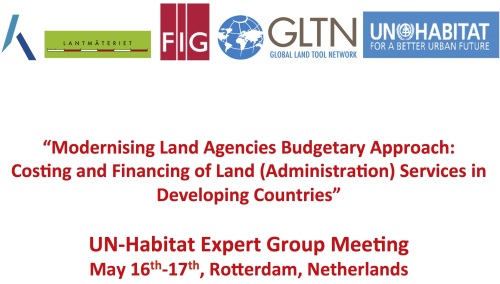News in 2013

|
UN-Habitat GLTN Expert Group Meeting
Modernising Land Agencies Budgetary Approach:
Costing and Financing of Land Administration Services in Developing
Countries
Rotterdam, Netherlands 16-17 May 2013
The Global Land Tools Network (GLTN) in collaboration with the
International Federation of Surveyors (FIG) supported by Kadaster
International and other partners and stakeholders have embarked on a process
to develop a tool that can assist policy makers and those responsible for
land administration to adopt appropriate technologies, methodologies and
processes that will provide land administration services more efficiently,
cost effectively and with options more appropriately tailored for
incorporating all tenure types. The Expert Group Meeting was held in
Rotterdam, Netherlands May 16-17, 2013 hosted by Kadaster International. The
meeting aims to bring the global experiences of land administration reform
professionals to understand the information that needs to be gathered within
this process.

It must be appreciated that there are significant economic and social
benefits for ensuring an inclusive land administration system. The
challenges that this tool will try to grapple with are finding optimal
solutions whereby these new realities and multiple trends can be
accommodated with a view to making land agencies relevant to the time and
the public they serve.
Land administration is first and foremost governmental responsibility.
Most developing countries use conventional land administration systems that
are often complex with rigid processes, grounded in dated methodologies and
standards and under resourced. Furthermore, land agencies lack adequate
funding to produce and deliver services, develop human resources, let alone
to expand the coverage of its services. Land agencies in many developing
jurisdictions are funded from the treasury to pay for operational
expenditures, while developmental expenditures are sought from international
development sources made available either through grants or concessional
loans. Even in countries where the land sector is one of the more prominent
sources of government revenue, allocation of resources to land agencies
typically remain inadequate. On the positive side, technology and innovative
approaches in delivering land services offer new ways of providing land
administration services at reduced cost and better efficiency.
The development of this tool, mindful of the social fabric of land
tenure, will concentrate investigations on the various costs and methods of
land administration service delivery and alternative means of financing such
services. The tool will not provide countries with single solution, but
instead will describe a range or ranges of options that can be appropriately
adopted according to the laws, policies, institutional arrangements and land
administration arrangements of the jurisdiction and the ability to enhance
as required. The tool will guide decision makers through an appropriate and
incremental process towards improving efficiencies with good practices and
budgetary options, but without compromising the quality of services
provided, nor limiting access to services especially for the poor and
vulnerable.
The two day meeting was attended by Solomon Haile and
Danilo
Antonio (UN-Habitat/GLTN); Tommy Osterberg (Lantmateriet,
Sweden); Kees de Zeeuw (Kadaster International, Netherlands); Soren F Christensen (Danish Geodata, Denmark);
Helge Onsrud
(Statkart, Norway); Jaap Zevenbergen (Uni of Twente, The
Netherlands); Kate Dalrymple and Tony Burns (UN-Habitat
consultants, Land Equity International, engaged for this process); Paul
van der Molen and CheeHai Teo (FIG).
The Global Land Tool Network (GLTN) main objective is to contribute to
poverty alleviation and the Millennium Development Goals through land
reform, improved land management and security of tenure. To achieve this
end, GLTN are developing various tools as a practical way to solve a problem
in land administration and management. It is envisaged as a way to put
principles, policies and legislation into effect through practical,
adaptable and applicable tools. Five thematic areas have been identified to
which 18 land tools are assigned. The thematic areas include:
1. Access to land and tenure security,
2. Land management and planning,
3. Land administration and information,
4. Land-based financing, and
5. Land policy and legislation.
In addition to these, there are also cross cutting issues being
addressed. Within the third theme two tools being developed,
3a. Spatial Units, and
3b. Modernising of land agencies budget approach
and this research is concerned about the latter.
CheeHai TEO
May 2013
21 May 2013
|
























